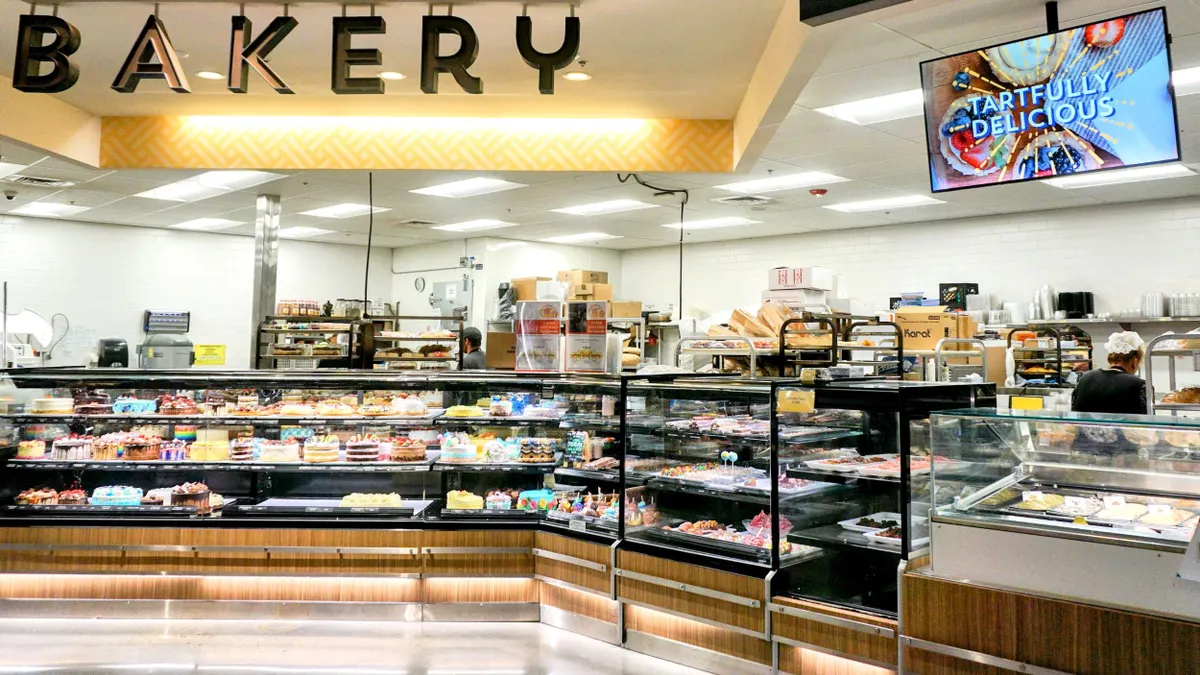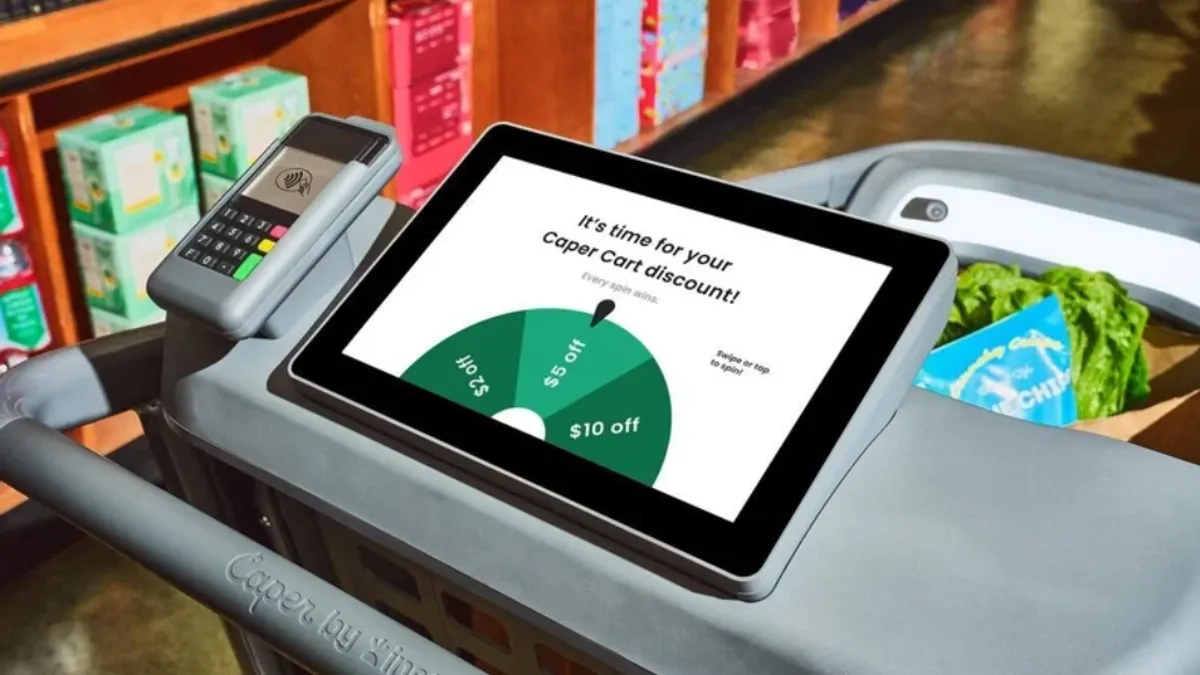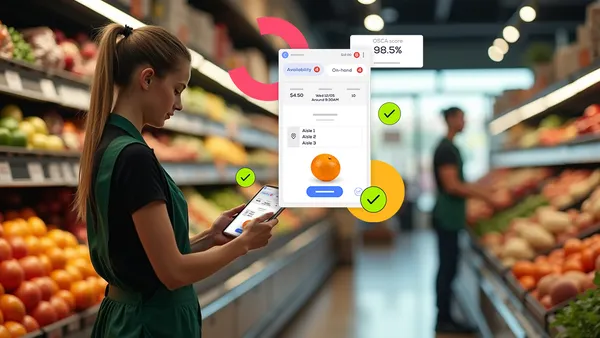This is the second article in a four-part series looking at labor issues affecting the grocery industry. The first article can be found here.
The automation of tasks and jobs in grocery retail is no longer a question of "if" but "when," and it’s picking up speed. But with the increased technology in stores, bigger questions remain for retailers and their employees. Will workers lose their jobs or adapt? How should retailers approach reskilling? Are robots eventually going to replace the thousands of cashiers and stockers across the industry?
According to research from the McKinsey & Company, about half of retail activities could be automated with existing technology, but the change is less about job loss and more about reskilling as well as the evolution of existing jobs and the creation of new ones. McKinsey found that just 5% of all jobs can be fully automated with current technology.
There is still more that grocery companies will discover on the journey to automation. For now, a central part of the process is how automation will affect their workforces and how best they can support employees in the process.
A snapshot of in-store technology at Sam's Club
One retailer that's leading the way in automation is Walmart. As the company has rolled out robots in its stores and warehouses, it has taken pains to address concerns shoppers and employees have over displaced jobs.
Walmart has characterized its expanding portfolio of robot workers, from its "Auto-C" floor cleaners to its "Auto-S" shelf scanners, as tools that empower employees by reducing the time workers spend on "more mundane and repetitive tasks." The company said employees responded well to the new technology in pilot programs last year.
"Our associates immediately understood the opportunity for the new technology to free them up from focusing on tasks that are repeatable, predictable and manual," John Crecelius, senior vice president of central operations for Walmart U.S., said in a recent company post. "It allows them time to focus more on selling merchandise and serving customers, which they tell us have always been the most exciting parts of working in retail."
That message extends to Walmart's sister chain, Sam's Club. During a keynote at Groceryshop in Las Vegas in September, Sam’s Club CEO John Furner said the company is using automation and technology in stores to augment work and replace tasks workers don’t like to do.
"The personal connection and the sense of the community that you can get from shopping with someone you trust is still really important," Furner told the audience.
Furner also noted that even with more automation in play, the total number of employees per club is actually about the same, and even higher in some places because of the addition of employees to support grocery pickup.
"So the total number of jobs is about the same, but the work has changed," he said.
Chad Donath, Sam’s Club's vice president of operations support, told Grocery Dive in an email the company is developing tools and technology to make associates feel more connected and engaged, and to allow them to work more closely with shoppers.
One such tool is an app called Ask Sam, which lets associates ask questions about anything in the club using their mobile device and receive immediate answers. For example, an associate can ask, "Who is working today?" or look up a recipe for a customer.
"It has saved our associates so much time that they used to spend leaving the sales floor to look something up in the back," Donath said.
The app also provides useful intelligence for Sam’s Club leadership because they see an unfiltered view of what associates want to know. "We can add capabilities if necessary," Donath said.
The employee perspective
Retailers like Schnucks and Walmart have positioned automation as a plus for workers — but that doesn't always square with how workers themselves see it. Managing their expectations is becoming key to the successful implementation of cutting-edge technology, experts say.
In March, the Center for Popular Democracy and United for Respect released a survey of 1,100 retail workers across the country examining what types of technology they're interacting with at the store level, their predictions on the future of work and the impact technology could have on them. The survey broke out findings by retail subsector, including grocery.
According to the findings, 62% of grocery store employees agree that technology will create new job opportunities. On the flip side, 63% of grocery workers agree that some of their job duties will be replaced by technology, while 36% agreed their entire job could be replaced by technology in their lifetime.
"What the retail workers felt was that tasks, rather than full jobs, were more likely to be replaced by technology," report author Maggie Corser, also a senior research analyst at the Center for Popular Democracy, told Grocery Dive. "What a lot of the results indicated was that technology was reconfiguring people’s jobs, not a consensus that technology is going to lead to wide-scale automation."
Dreama Lovett, 54, a Walmart employee and part of United for Respect, currently works in online grocery fulfillment at a store in Jacksonville, Florida. Lovett told Grocery Dive that without automation, she wouldn’t have her current job.
"But it’s also turning around and people are losing their jobs, too," she said.
Since Lovett joined Walmart three years ago, she said she has seen an increase in self-checkouts and has also witnessed the introduction of two robots to the store. The first assisted with shelf-scanning and stocking, which Lovett said can make a big difference in keeping inventory and store count correct.
The second robot to arrive at Walmart was a floor cleaning robot, which Lovett said has replaced most of the employees previously responsible for the task.
According to the joint report, just 2% of workers surveyed report the presence of robots stocking shelves or providing some service in stores. About 32% report self-checkout kiosks, and 15% report availability of a self-checkout app. Sixty percent of those surveyed said they use computer kiosks, iPads or hand-held devices to provide product information.
"What the retail workers felt was that tasks, rather than full jobs, were more likely to be replaced by technology."

Maggie Corser
Report author and senior research analyst, Center for Popular Democracy
There’s no doubt automated technology has arrived in grocery retail, but the speed of adoption and degree at which it is being deployed varies by company.
"I think companies can choose to deploy technology in ways that automate work or they can reconfigure work in a way that supports their employees and their customers," Corser said.
Sajal Kohli, a senior partner with McKinsey who leads the retail practice for the Americas, told Grocery Dive it’s important for employers to be transparent when the organization is exploring store automation.
"I would just call that table stakes, actually, having an open conversation about it," Kohli said.
The importance of reskilling and cross-training
Beyond messaging, the presence of automation in stores demands a new set of skills for employees. How employers approach this transition is essential to their success and reputation among employees and the public, sources said.
"There are some organizations that are essentially just getting rid of roles and the people in those roles, where you see massive layoffs in droves for some companies," Sari Wilde, managing vice president in Gartner’s human resources practice, told Grocery Dive. "On the other side, you see companies who are taking a lot of responsibility for the retraining of their employees."
Kohli with McKinsey noted that training at grocery stores is not a new phenomenon. Companies have always had training programs in place around the functional and technical nature of jobs and for food safety purposes.
"I think the question is, have you now infused reskilling in there?" Kohli said, noting the importance of offering cross-training so employees can fill multiple jobs, or reskilling them for a new role.
Some companies say they are slow to adopt automation because they can’t find the necessary talent, according to a recent whitepaper from McKinsey. But the firm estimates that only half the digital skills needed are available in the labor pool. While some employers may look to bring on new employees that possess digital and technological skills, McKinsey found it is far more cost-effective to reskill employees. It costs a company 10% of an employee’s annual salary to reskill them on average, while replacing an employee can cost 20% to 30%. It’s also necessary to provide reskilling to bridge the skills gap, McKinsey found.
With so many other priorities inundating retailers and other companies, however, reskilling has yet to become a priority across industries. According to a recent Accenture survey of 1,200 executives, just 3% said they aim to significantly boost their training budgets over the next three years.
To date, Amazon is one of the only major retailers that has announced a comprehensive plan to invest in training to provide employees with digital workplace skills. The e-tailer plans to spend $700 million to reskill 100 million employees. Some of the new skill sets support jobs such as floor control specialist, which oversees robots.
Laura Strange, vice president of communications for the National Grocers Association (NGA), told Grocery Dive many of its members are making sure employees are getting experience in numerous departments. The training isn't geared specifically toward automation, she said.
"Whether that’s front of store, deli, management, you name it, people are trying to cross-train and make sure that people [employees] have exposure and experience in different departments throughout the grocery store," Strange said.
NGA, which represents a cohort of independent grocery companies across the U.S., offers an online training platform with more than 170 grocery-specific courses for its members. For example, someone can start a course, pause it to go to work, and pick up where they left off on their lunch hour or after work. Strange said NGA regularly adds new courses based on needs and requests from its members.
While automation in independent grocery stores may not be as widespread or fast-growing as larger retailers, it has still been a disruptive force and training remains a big emphasis for independents, according to Strange.
"There are some organizations that are essentially just getting rid of roles and the people in those roles, where you see massive layoffs in droves for some companies. On the other side you see companies who are taking a lot of responsibility for the retraining of their employees."

Sari Wilde
Managing vice president, Gartner’s HR practice.
At Sam’s Club, employees have access to a newly launched, interactive training experience called Fresh Learning Lab. The program is geared toward training associates across the fresh food department, from meat cutters to cake decorators, Donath said.
While Fresh Learning Lab isn’t specific to automation or technology, it aligns with Sam’s Club’s goal to teach team members to work across the store.
"Associates are constantly learning about how to do new tasks and work in different areas," Donath said. "In general, a lot of our training happens while our associates are on the sales floor working. In addition to cross-training, associates can access most of our training tools via a mobile app."
At Groceryshop, Furner said Sam’s Club sees about two-thirds to three-fourths of associates that are asked to move to another job are willing to do so.
Include employee voices
As automation either displaces or redefines certain roles in grocery stores, experts say it is imperative for employers to listen to employees' feedback and ideas for the future. It’s also important to understand what each employee wants out of their role and their career with a company.
"The first thing is you have to be connected to the employees and take a pulse of their career interests," Wilde said. "I think in some cases organizations have found that their employees want a completely new career path and they want those kinds of opportunities. In other organizations, they may not be interested and may be looking just to go to another company who’s not at that automation stage."
Wilde said Gartner’s research has found organizations asking employees what part of their jobs could be automated. “Sometimes the employees or their managers may know that even better than the leaders,” she said.
Kohli said he doesn’t think all retailers are taking to heart the need to have employees and associates to be involved in the journey of automation — but they should.
"A lot of these colleagues will actually have really good ideas on where the automation potential is going to be good versus not,” he said. "Having a dialogue with employees also helps an organization to build a change management journey for those who might eventually get impacted."





















